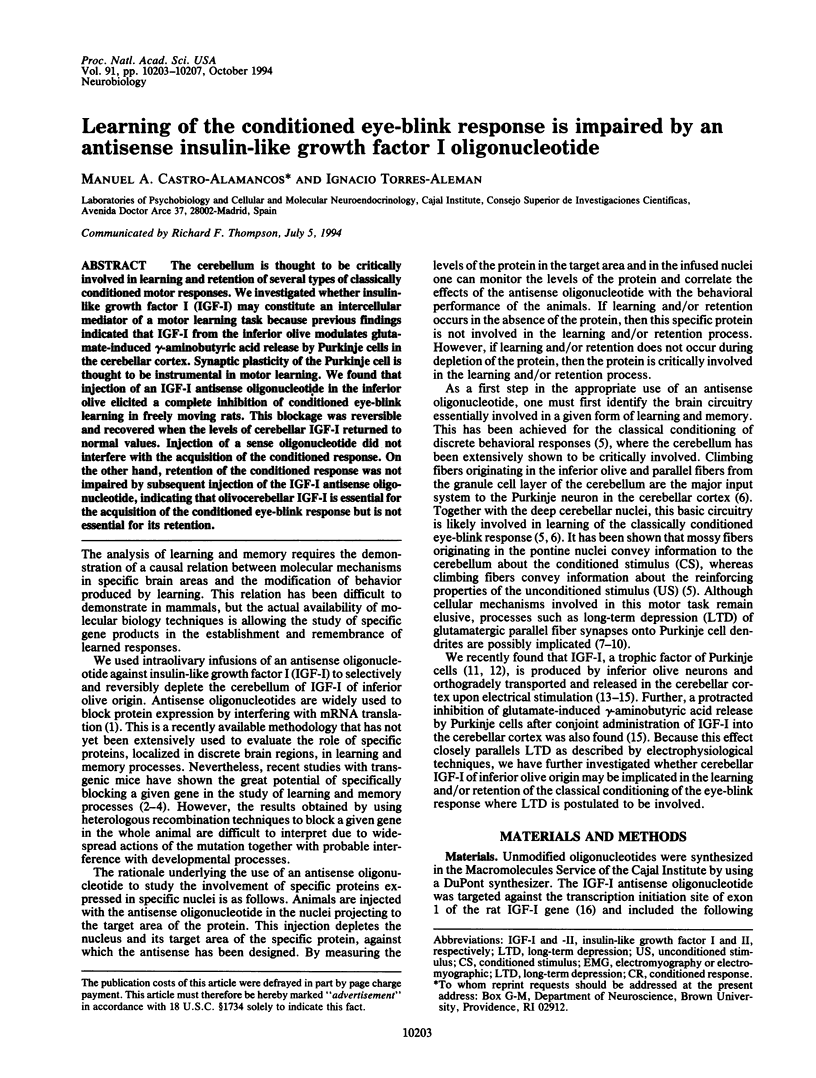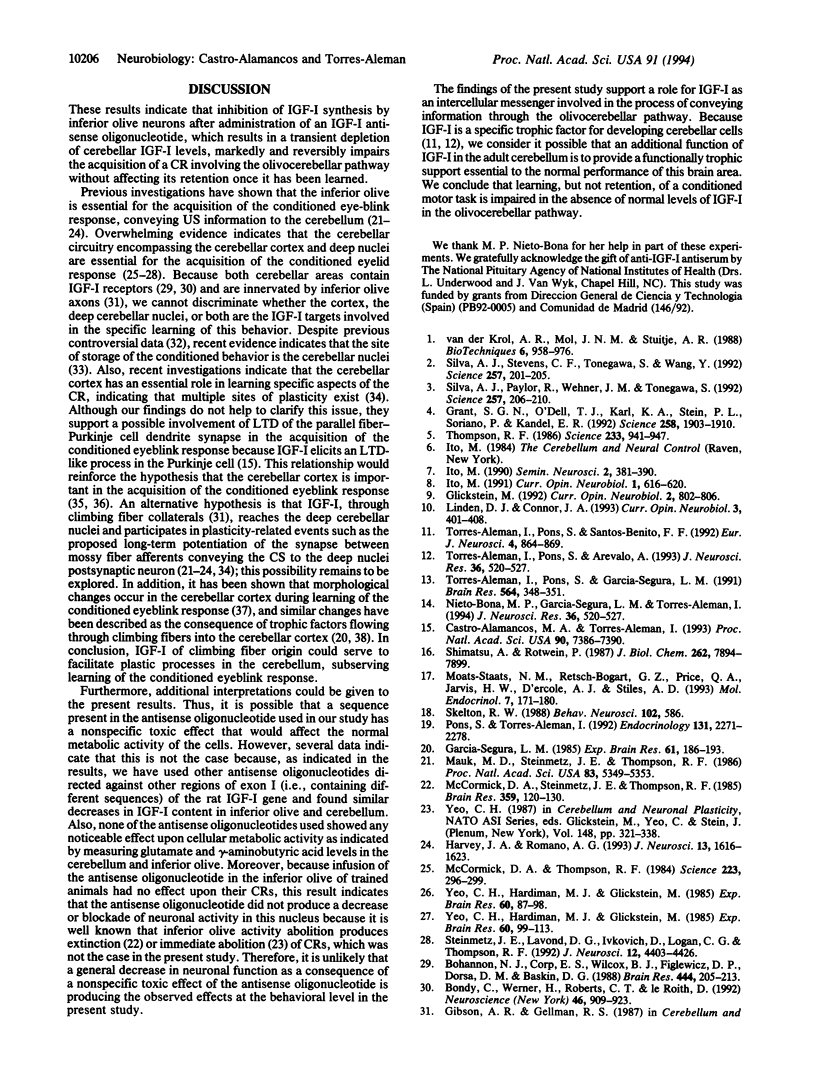Abstract
The cerebellum is thought to be critically involved in learning and retention of several types of classically conditioned motor responses. We investigated whether insulin-like growth factor I (IGF-I) may constitute an intercellular mediator of a motor learning task because previous findings indicated that IGF-I from the inferior olive modulates glutamate-induced gamma-aminobutyric acid release by Purkinje cells in the cerebellar cortex. Synaptic plasticity of the Purkinje cell is thought to be instrumental in motor learning. We found that injection of an IGF-I antisense oligonucleotide in the inferior olive elicited a complete inhibition of conditioned eye-blink learning in freely moving rats. This blockage was reversible and recovered when the levels of cerebellar IGF-I returned to normal values. Injection of a sense oligonucleotide did not interfere with the acquisition of the conditioned response. On the other hand, retention of the conditioned response was not impaired by subsequent injection of the IGF-I antisense oligonucleotide, indicating that olivocerebellar IGF-I is essential for the acquisition of the conditioned eye-blink response but is not essential for its retention.
Full text
PDF




Selected References
These references are in PubMed. This may not be the complete list of references from this article.
- Baetens D., Tribollet E., Garcia-Segura L. M. Colchicine injection in the inferior olivary nucleus increases the number of Purkinje cell dendritic spines. Neurosci Lett. 1983 Aug 8;38(3):239–244. doi: 10.1016/0304-3940(83)90375-0. [DOI] [PubMed] [Google Scholar]
- Bohannon N. J., Corp E. S., Wilcox B. J., Figlewicz D. P., Dorsa D. M., Baskin D. G. Localization of binding sites for insulin-like growth factor-I (IGF-I) in the rat brain by quantitative autoradiography. Brain Res. 1988 Mar 22;444(2):205–213. doi: 10.1016/0006-8993(88)90931-6. [DOI] [PubMed] [Google Scholar]
- Bondy C., Werner H., Roberts C. T., Jr, LeRoith D. Cellular pattern of type-I insulin-like growth factor receptor gene expression during maturation of the rat brain: comparison with insulin-like growth factors I and II. Neuroscience. 1992;46(4):909–923. doi: 10.1016/0306-4522(92)90193-6. [DOI] [PubMed] [Google Scholar]
- Castro-Alamancos M. A., Torres-Aleman I. Long-term depression of glutamate-induced gamma-aminobutyric acid release in cerebellum by insulin-like growth factor I. Proc Natl Acad Sci U S A. 1993 Aug 1;90(15):7386–7390. doi: 10.1073/pnas.90.15.7386. [DOI] [PMC free article] [PubMed] [Google Scholar]
- Garcia-Segura L. M. Trans-synaptic modulation of Purkinje cell plasma membrane organization by climbing fiber axonal flow. Exp Brain Res. 1985;61(1):186–193. doi: 10.1007/BF00235634. [DOI] [PubMed] [Google Scholar]
- Glickstein M. The cerebellum and motor learning. Curr Opin Neurobiol. 1992 Dec;2(6):802–806. doi: 10.1016/0959-4388(92)90137-a. [DOI] [PubMed] [Google Scholar]
- Grant S. G., O'Dell T. J., Karl K. A., Stein P. L., Soriano P., Kandel E. R. Impaired long-term potentiation, spatial learning, and hippocampal development in fyn mutant mice. Science. 1992 Dec 18;258(5090):1903–1910. doi: 10.1126/science.1361685. [DOI] [PubMed] [Google Scholar]
- Harvey J. A., Romano A. G. Harmaline-induced impairment of Pavlovian conditioning in the rabbit. J Neurosci. 1993 Apr;13(4):1616–1623. doi: 10.1523/JNEUROSCI.13-04-01616.1993. [DOI] [PMC free article] [PubMed] [Google Scholar]
- Ito M. The cellular basis of cerebellar plasticity. Curr Opin Neurobiol. 1991 Dec;1(4):616–620. doi: 10.1016/s0959-4388(05)80038-8. [DOI] [PubMed] [Google Scholar]
- Krupa D. J., Thompson J. K., Thompson R. F. Localization of a memory trace in the mammalian brain. Science. 1993 May 14;260(5110):989–991. doi: 10.1126/science.8493536. [DOI] [PubMed] [Google Scholar]
- Lavond D. G., Steinmetz J. E. Acquisition of classical conditioning without cerebellar cortex. Behav Brain Res. 1989 Jun 1;33(2):113–164. doi: 10.1016/s0166-4328(89)80047-6. [DOI] [PubMed] [Google Scholar]
- Lincoln J. S., McCormick D. A., Thompson R. F. Ipsilateral cerebellar lesions prevent learning of the classically conditioned nictitating membrane/eyelid response. Brain Res. 1982 Jun 17;242(1):190–193. doi: 10.1016/0006-8993(82)90510-8. [DOI] [PubMed] [Google Scholar]
- Linden D. J., Connor J. A. Cellular mechanisms of long-term depression in the cerebellum. Curr Opin Neurobiol. 1993 Jun;3(3):401–406. doi: 10.1016/0959-4388(93)90133-j. [DOI] [PubMed] [Google Scholar]
- Mauk M. D., Steinmetz J. E., Thompson R. F. Classical conditioning using stimulation of the inferior olive as the unconditioned stimulus. Proc Natl Acad Sci U S A. 1986 Jul;83(14):5349–5353. doi: 10.1073/pnas.83.14.5349. [DOI] [PMC free article] [PubMed] [Google Scholar]
- McCormick D. A., Steinmetz J. E., Thompson R. F. Lesions of the inferior olivary complex cause extinction of the classically conditioned eyeblink response. Brain Res. 1985 Dec 16;359(1-2):120–130. doi: 10.1016/0006-8993(85)91419-2. [DOI] [PubMed] [Google Scholar]
- McCormick D. A., Thompson R. F. Cerebellum: essential involvement in the classically conditioned eyelid response. Science. 1984 Jan 20;223(4633):296–299. doi: 10.1126/science.6701513. [DOI] [PubMed] [Google Scholar]
- Moats-Staats B. M., Retsch-Bogart G. Z., Price W. A., Jarvis H. W., D'Ercole A. J., Stiles A. D. Insulin-like growth factor-I (IGF-I) antisense oligodeoxynucleotide mediated inhibition of DNA synthesis by WI-38 cells: evidence for autocrine actions of IGF-I. Mol Endocrinol. 1993 Feb;7(2):171–180. doi: 10.1210/mend.7.2.7682287. [DOI] [PubMed] [Google Scholar]
- Nieto-Bona M. P., Garcia-Segura L. M., Torres-Aleman I. Orthograde transport and release of insulin-like growth factor I from the inferior olive to the cerebellum. J Neurosci Res. 1993 Dec 1;36(5):520–527. doi: 10.1002/jnr.490360504. [DOI] [PubMed] [Google Scholar]
- Nieto-Bona M. P., Garcia-Segura L. M., Torres-Aleman I. Orthograde transport and release of insulin-like growth factor I from the inferior olive to the cerebellum. J Neurosci Res. 1993 Dec 1;36(5):520–527. doi: 10.1002/jnr.490360504. [DOI] [PubMed] [Google Scholar]
- Perrett S. P., Ruiz B. P., Mauk M. D. Cerebellar cortex lesions disrupt learning-dependent timing of conditioned eyelid responses. J Neurosci. 1993 Apr;13(4):1708–1718. doi: 10.1523/JNEUROSCI.13-04-01708.1993. [DOI] [PMC free article] [PubMed] [Google Scholar]
- Pons S., Torres-Aleman I. Basic fibroblast growth factor modulates insulin-like growth factor-I, its receptor, and its binding proteins in hypothalamic cell cultures. Endocrinology. 1992 Nov;131(5):2271–2278. doi: 10.1210/endo.131.5.1385099. [DOI] [PubMed] [Google Scholar]
- Shimatsu A., Rotwein P. Mosaic evolution of the insulin-like growth factors. Organization, sequence, and expression of the rat insulin-like growth factor I gene. J Biol Chem. 1987 Jun 5;262(16):7894–7900. [PubMed] [Google Scholar]
- Silva A. J., Paylor R., Wehner J. M., Tonegawa S. Impaired spatial learning in alpha-calcium-calmodulin kinase II mutant mice. Science. 1992 Jul 10;257(5067):206–211. doi: 10.1126/science.1321493. [DOI] [PubMed] [Google Scholar]
- Silva A. J., Stevens C. F., Tonegawa S., Wang Y. Deficient hippocampal long-term potentiation in alpha-calcium-calmodulin kinase II mutant mice. Science. 1992 Jul 10;257(5067):201–206. doi: 10.1126/science.1378648. [DOI] [PubMed] [Google Scholar]
- Skelton R. W. Bilateral cerebellar lesions disrupt conditioned eyelid responses in unrestrained rats. Behav Neurosci. 1988 Aug;102(4):586–590. doi: 10.1037//0735-7044.102.4.586. [DOI] [PubMed] [Google Scholar]
- Steinmetz J. E., Lavond D. G., Ivkovich D., Logan C. G., Thompson R. F. Disruption of classical eyelid conditioning after cerebellar lesions: damage to a memory trace system or a simple performance deficit? J Neurosci. 1992 Nov;12(11):4403–4426. doi: 10.1523/JNEUROSCI.12-11-04403.1992. [DOI] [PMC free article] [PubMed] [Google Scholar]
- Thompson R. F. The neurobiology of learning and memory. Science. 1986 Aug 29;233(4767):941–947. doi: 10.1126/science.3738519. [DOI] [PubMed] [Google Scholar]
- Torres-Aleman I., Pons S., Santos-Benito F. F. Survival of Purkinje Cells in Cerebellar Cultures is Increased by Insulin-like Growth Factor I. Eur J Neurosci. 1992;4(9):864–869. doi: 10.1111/j.1460-9568.1992.tb00196.x. [DOI] [PubMed] [Google Scholar]
- Torres-Alemán I., Pons S., García-Segura L. M. Climbing fiber deafferentation reduces insulin-like growth factor I (IGF-I) content in cerebellum. Brain Res. 1991 Nov 15;564(2):348–351. doi: 10.1016/0006-8993(91)91476-h. [DOI] [PubMed] [Google Scholar]
- Welsh J. P., Harvey J. A. Pavlovian conditioning in the rabbit during inactivation of the interpositus nucleus. J Physiol. 1991 Dec;444:459–480. doi: 10.1113/jphysiol.1991.sp018888. [DOI] [PMC free article] [PubMed] [Google Scholar]
- Yeo C. H., Hardiman M. J., Glickstein M. Classical conditioning of the nictitating membrane response of the rabbit. I. Lesions of the cerebellar nuclei. Exp Brain Res. 1985;60(1):87–98. doi: 10.1007/BF00237022. [DOI] [PubMed] [Google Scholar]
- Yeo C. H., Hardiman M. J., Glickstein M. Classical conditioning of the nictitating membrane response of the rabbit. II. Lesions of the cerebellar cortex. Exp Brain Res. 1985;60(1):99–113. doi: 10.1007/BF00237023. [DOI] [PubMed] [Google Scholar]
- van der Krol A. R., Mol J. N., Stuitje A. R. Modulation of eukaryotic gene expression by complementary RNA or DNA sequences. Biotechniques. 1988 Nov-Dec;6(10):958–976. [PubMed] [Google Scholar]


